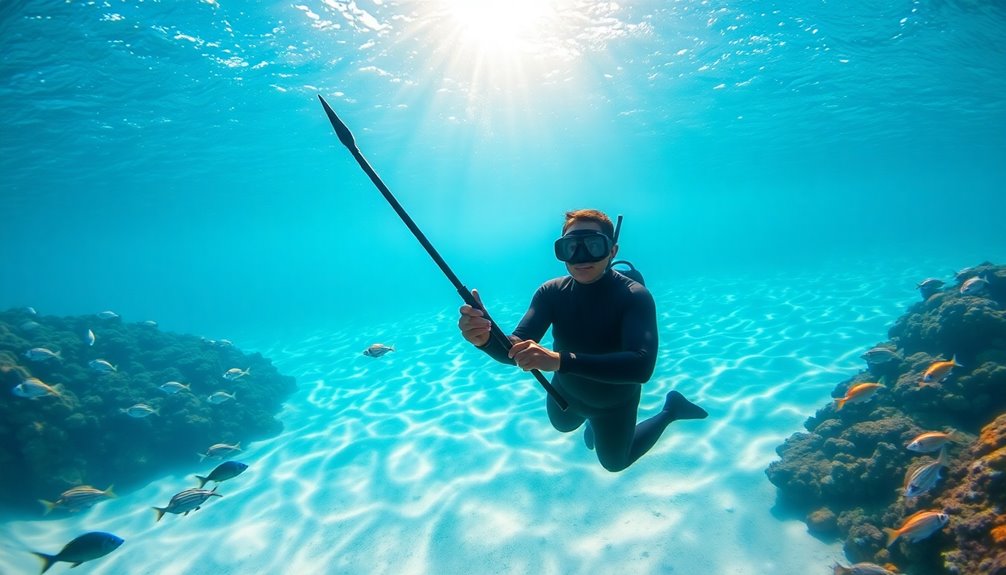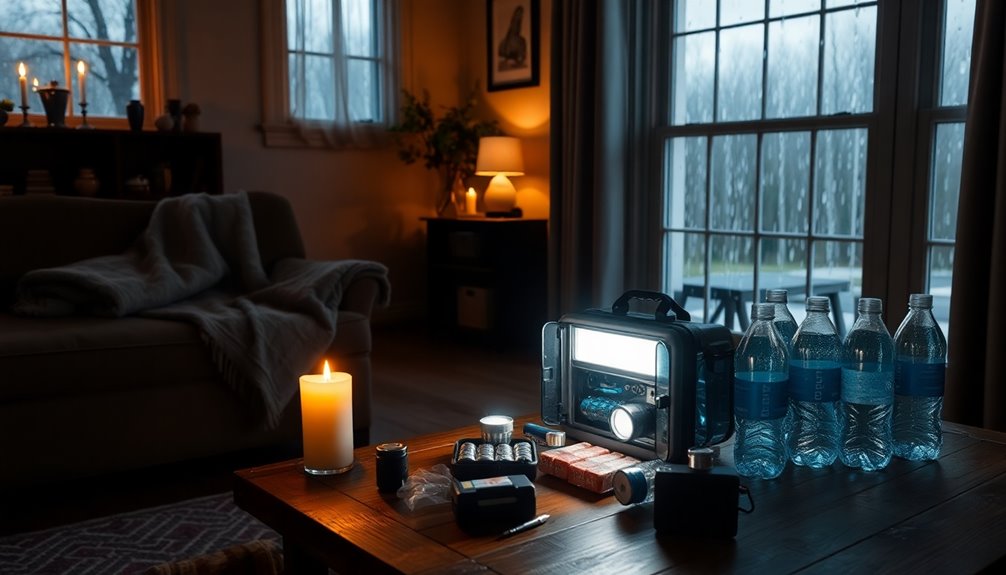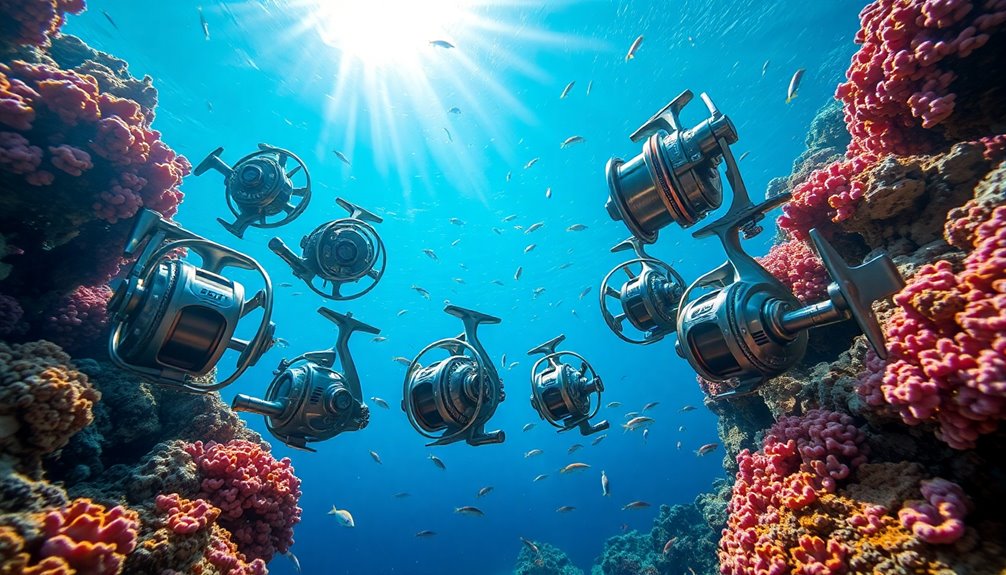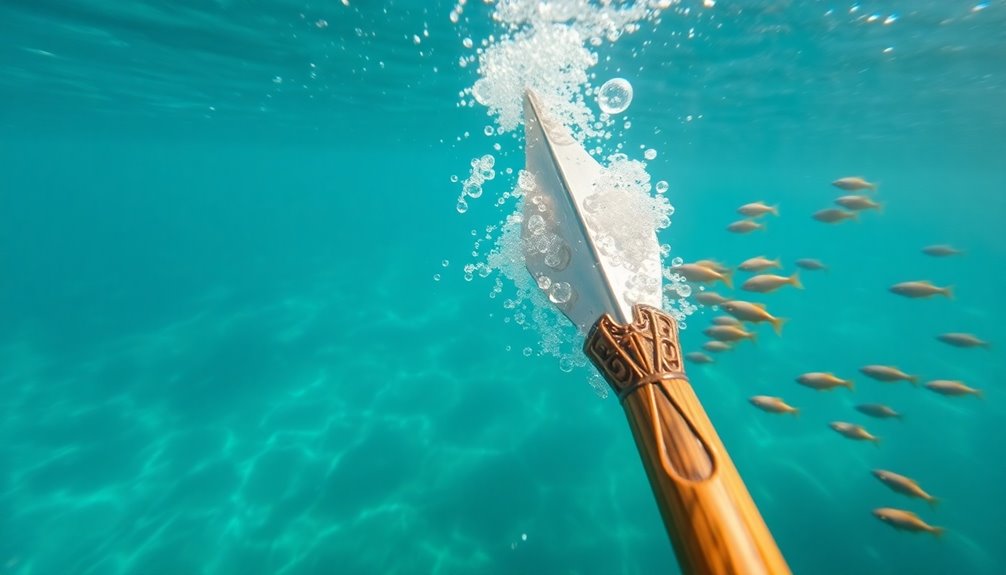If you're looking to start spearfishing, you're in for an exciting journey! First, invest in essential gear like a 1.1-meter speargun, mask, and fins. Safety is vital, so always load your speargun underwater and stay aware of your surroundings. Understanding fish behavior helps you choose the best hunting locations, like reefs and rocky structures. Embrace sustainable practices to respect marine life and enhance your experience. Remember, patience is key—let fish come to you rather than chasing them. With these tips, you're on your way to mastering underwater hunting. There's so much more you can uncover along the way!
Key Takeaways
- Invest in essential gear like a speargun, mask, snorkel, fins, and safety equipment for a successful start in spearfishing.
- Familiarize yourself with sustainable practices to respect marine life and promote responsible harvesting.
- Understand fish behavior and ideal hunting locations to increase your chances of success underwater.
- Master speargun loading techniques and maintenance for enhanced safety and effectiveness while hunting.
- Practice patience and observation to strategically intercept fish, improving your overall spearfishing experience.
Community Values in Spearfishing
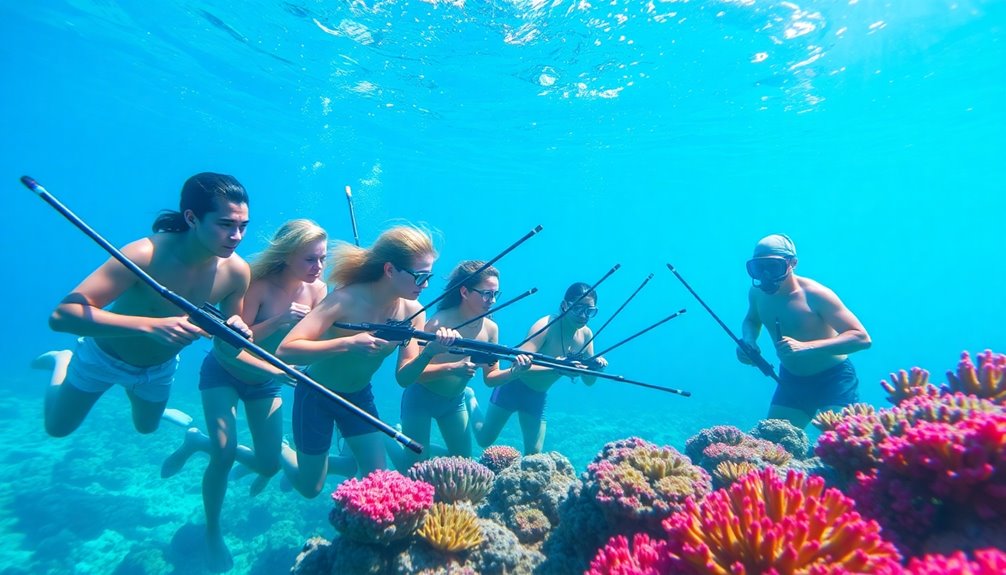
In the world of spearfishing, community values play a significant role in shaping responsible practices and fostering a supportive environment. You'll find that community support is fundamental for newcomers, as experienced divers are enthusiastic to share their knowledge and tips. This culture of mentorship helps you adopt responsible practices that align with the collective values of the spearfishing community.
Respect for marine life and the environment is a core principle. By promoting sustainable practices, you'll learn to minimize bycatch and only take what you need. This not only guarantees the health of marine ecosystems but also reinforces a sense of accountability within the community.
You might face criticism from non-supporters, but remember that ethical hunting and responsible sourcing of food through spearfishing can be a fulfilling and sustainable choice.
As you immerse yourself in this community, you'll find that adhering to regulations, like maintaining legal sizes for target fish species, is essential. This respect for rules reflects the community's commitment to preserving underwater environments while fostering a network that encourages sustainable fishing efforts.
Embrace these values, and you'll thrive in your spearfishing journey.
Essential Gear for Beginners
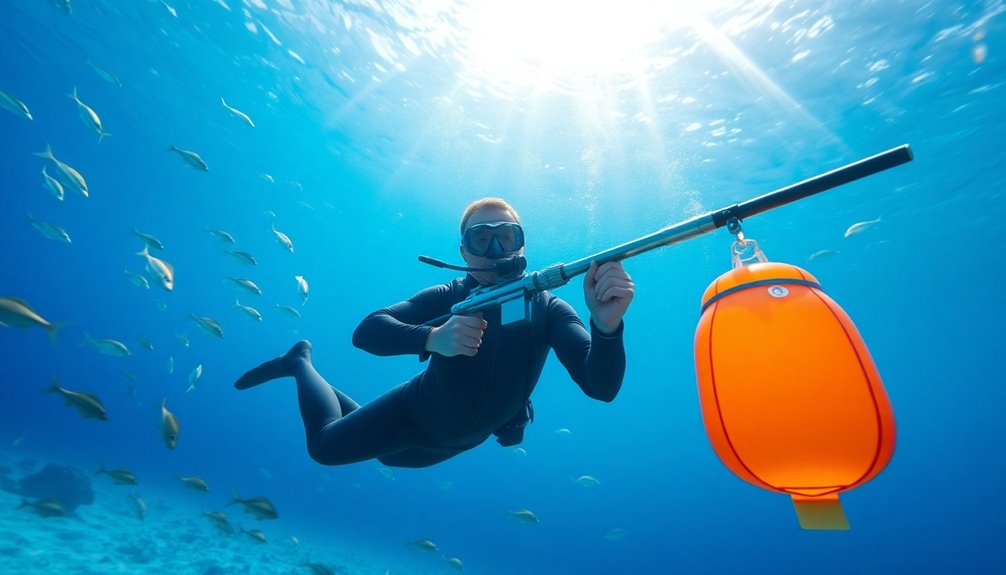
Choosing the right gear is vital for your success and safety in spearfishing. Your initial investment in spearfishing gear can reach around 1,000 AUD, but this cost covers all the necessary items you'll need.
Start with a quality speargun; a 1.1-meter gun is ideal for beginners, offering a balance of safety and effectiveness. It's important to have proper safety equipment to guarantee a secure experience underwater.
You'll also need a mask, snorkel, fins, and a weight belt. These items enhance your maneuverability and help maintain buoyancy while you hunt.
Don't forget about dry backpacks or dry bags for transporting your gear; these keep everything dry and salt-free, extending the lifespan of your equipment.
As you gain experience, you might find yourself upgrading your gear based on your needs.
Speargun Setup and Loading
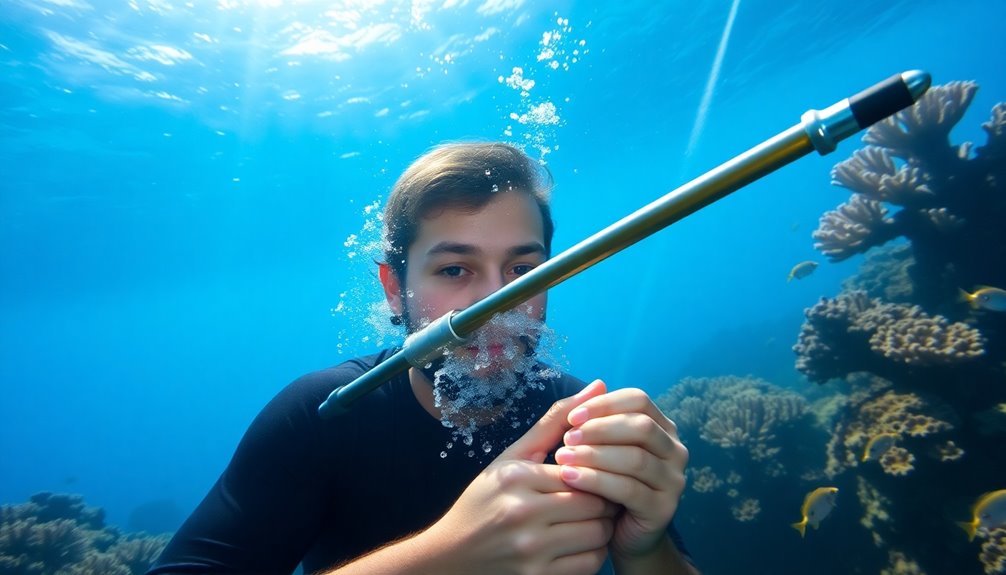
When setting up your speargun, choosing the right size is vital for effective targeting.
You'll need to master loading techniques for both safety and efficiency, especially when aiming for larger fish.
Choosing the Right Speargun
Selecting the right speargun is essential for both safety and success in spearfishing. As a beginner, you'll want to start with a 1.1-meter speargun. It strikes a balance between maneuverability and stopping power, making it suitable for various fish sizes. The Ocean Hunter 300mm railgun is another excellent option designed for accuracy, perfect for those just starting out.
When choosing your speargun, consider its weight and ease of use. A lighter gun can help maintain control and reduce fatigue during long dives.
Remember, safety comes first; never aim your speargun at others, even when loading.
Loading your speargun involves pulling back the rubbers and securing the spear, which requires both hands underwater. For added safety, avoid loading the second rubber when targeting small, close-range fish. This not only enhances safety but also increases your efficiency during the hunt.
Regular maintenance and inspections of your speargun are vital. Ensuring that your gear remains in top condition will help guarantee your safety and effectiveness while underwater, making your spearfishing experience enjoyable and successful.
Loading Techniques Explained
Once you have your speargun ready, understanding how to load it properly is essential to a successful hunt. Here are three important loading techniques to keep in mind:
- Securely Pull the Rubbers: Use both hands to pull back the rubbers on your speargun. This provides stability and guarantees effective loading underwater.
- Insert the Spear: While maintaining your grip on the rubbers, insert the spear into the gun. This step is critical for accuracy and efficiency during your dive.
- Load in the Water: Always load your speargun in the water. This minimizes risks and helps avoid aiming at others, which is crucial for safety.
For small, close-range fish, consider not loading the second rubber; this allows for quicker shots.
Remember that your effective shooting distance is approximately four meters, so aim wisely. Regular maintenance and inspections of your speargun are also essential for peak performance.
Safety Precautions Required
Guaranteeing your safety while setting up and loading your speargun is vital for a successful and enjoyable dive. Always load your speargun only when you're in the water, and never aim it at others. This simple practice keeps everyone safe during your underwater hunting adventures.
When loading, use both hands to pull back the rubbers and secure the spear effectively. This technique not only improves accuracy but also enhances your overall control.
For small, close-range fish, consider avoiding the second rubber when loading your speargun. This reduces potential recoil and increases your safety. Remember, a larger speargun does offer more stopping power for bigger fish, but starting with a 1.1-meter gun is often better for beginners. It's easier to handle and promotes safety.
Regular maintenance of your speargun is essential. Inspect it frequently to guarantee its reliability and to uphold safety standards. By prioritizing maintenance, you'll enhance your spearfishing experience and reduce the risk of malfunctions. Additionally, understanding primitive weapons can provide valuable insights into crafting your own spearfishing gear for improved self-reliance.
Always keep these safety precautions in mind, and you'll be well on your way to underwater hunting glory!
Safety and Diving Techniques
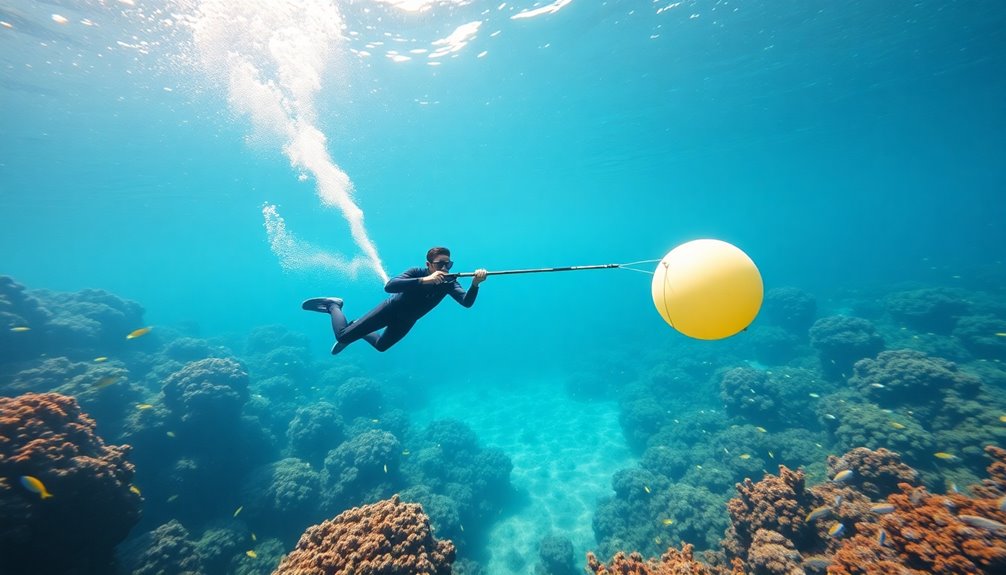
When it comes to safety and diving techniques in spearfishing, you can't underestimate the importance of preparation and awareness. Mastering these elements can greatly enhance your experience and keep you safe underwater.
Here are three key tips to improve your spearfishing safety:
- Train Your Breath-Holding Capabilities: Use apnea training apps to boost your breath-holding skills. This will help you manage the urge to breathe while hunting, allowing you to stay underwater longer and increase your chances of success.
- Conserve Energy During Shore Dives: Space out your dives to prevent fatigue. This approach enhances your performance and helps you stay alert to potential dangers in the water.
- Be Cautious in Shark-Prone Waters: Avoid shooting fish in these areas, and always dispatch any shot fish immediately.
Don't bleed or gut fish in the water to minimize attracting predators, especially if you're diving alone.
Understanding Fish Behavior
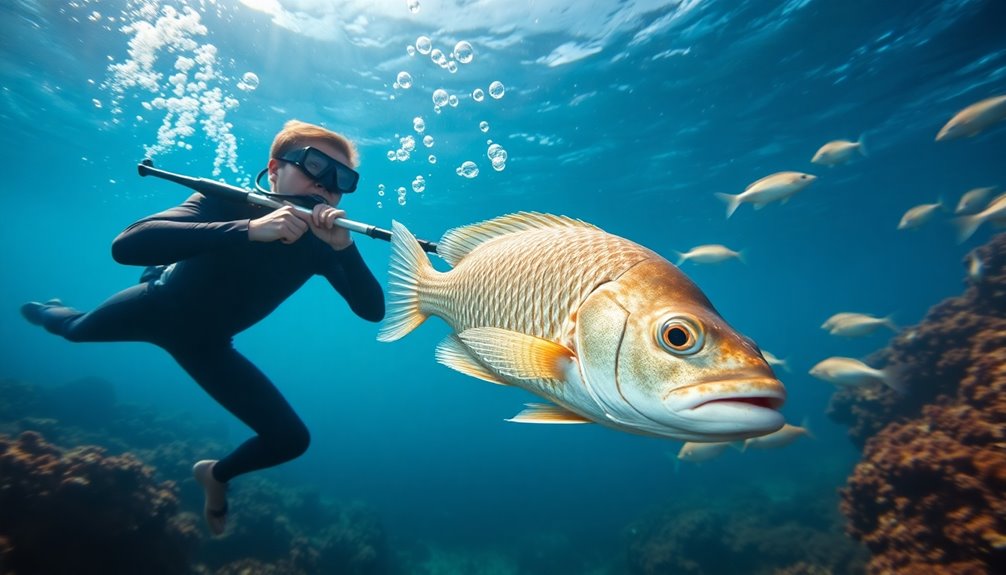
Understanding fish behavior is essential for successful spearfishing. To increase your chances, focus on how fish interact with their environment. Fish are naturally drawn to structured areas like rocks, submerged reefs, and bombies. These spots offer shelter and food, making them prime locations for your hunt.
Instead of chasing fish or making direct eye contact, learn their individual behaviors. By intercepting fish paths, you can position yourself to catch them off guard. Many species are curious and may approach when they feel relaxed. Patience is key here; let them come to you.
Creating disturbances can also be an effective tactic. Stirring up sand or gently tapping the water can pique a fish's curiosity, drawing them closer to your location. This technique mimics natural occurrences in their habitat, making them less wary and more likely to investigate.
Lastly, always adapt to varying water conditions. Understanding fish behavior in relation to these factors not only enhances your effectiveness but also guarantees your safety and enjoyment while spearfishing.
Ideal Hunting Locations
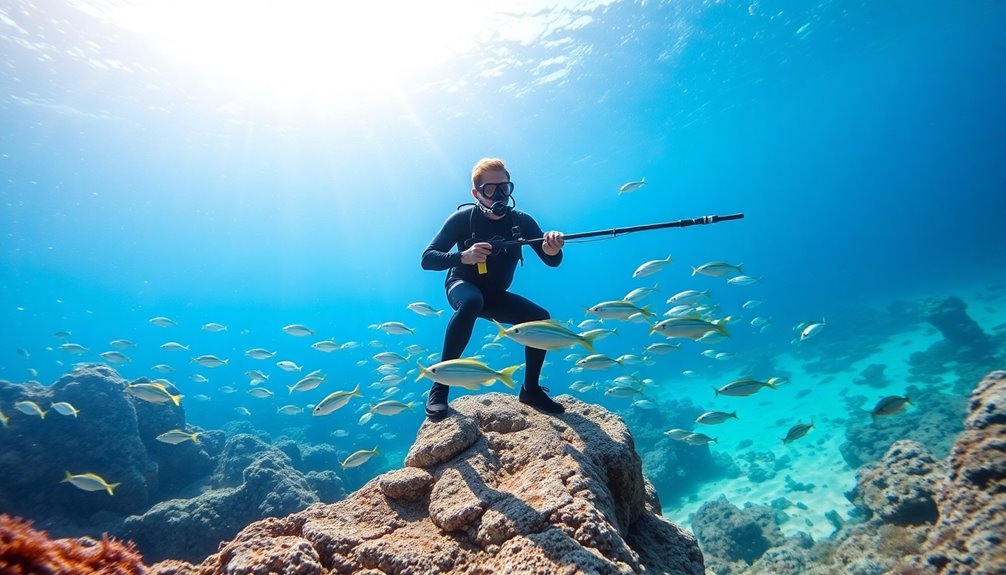
Diving into the water, you'll want to target spots where fish feel at home. The right locations can make all the difference in your spearfishing success. Here are three ideal hunting locations to take into account:
- Rocks and Submerged Reefs: These structured environments provide shelter and food, attracting various fish species.
- Bombies: These underwater structures create a perfect habitat for fish, making them prime spots for your hunt.
- Natural Cover: Look for areas with seaweed, corals, or other natural features that offer refuge for fish.
As you explore these locations, avoid direct eye contact and don't chase fish. Instead, position yourself strategically to intercept their paths. You might even create disturbances by stirring up sand, which can draw fish closer.
Remember, exploration can be just as effective as hunting; snorkeling can help you uncover larger species hiding in these environments.
Always prioritize safety and stay aware of changing water conditions while targeting these prime locations. By honing in on structured environments and underwater structures, you'll increase your chances of an enjoyable and successful spearfishing experience.
Sustainable Practices in Spearfishing
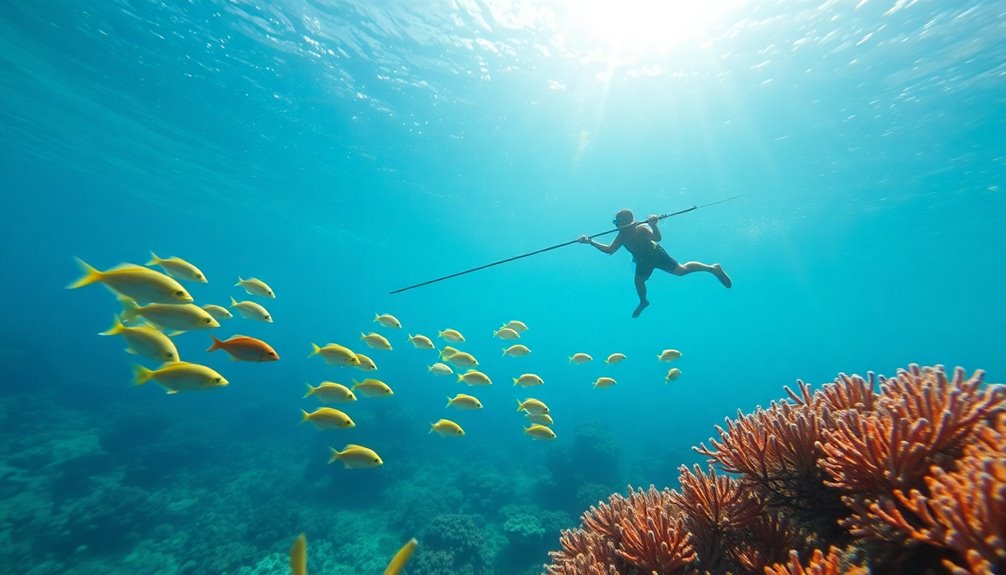
One of the most rewarding aspects of spearfishing is its emphasis on sustainability. By choosing spearfishing over traditional fishing methods, you greatly reduce bycatch, allowing for more responsible harvesting of marine life. This method encourages you to take only what's necessary, helping maintain healthy fish populations and preserving the delicate balance of marine environments.
Respecting these environments is vital. As you dive, keep in mind the importance of avoiding damage to reefs and habitats. This respect not only benefits the ecosystem but also helps foster a positive image of spearfishing within the community.
Adhering to legal size limits for target fish species is another key aspect of sustainable practices. By doing so, you contribute to population sustainability and promote responsible fishing habits among fellow beginners.
Engaging in these ethical practices strengthens community support and acceptance, even amidst criticism from non-supporters. Ultimately, by committing to sustainable practices, you guarantee that future generations can enjoy the same underwater hunting glory you do today.
Embrace these principles, and you'll make a positive impact while enjoying your spearfishing adventures.
Frequently Asked Questions
Why Is Spearfishing Illegal?
Spearfishing can be illegal due to regulations aimed at protecting fish populations and maintaining sustainability.
In certain areas, it's banned during spawning seasons to help fish recover and reproduce. You might also find legal size limits enforced to prevent overfishing.
Additionally, some jurisdictions prohibit spearfishing in protected marine areas to preserve biodiversity.
If you don't follow these laws, you could face fines, gear confiscation, or even legal repercussions.
Always check local regulations before diving in!
Where to Spear Fish for Beginners?
So, you wanna plunge into the deep blue and play fish assassin? Start by scoping out structured spots like rocks and reefs—fish love a good hangout.
Stay away from shark hotspots; they're not fans of competition. Check the local laws, 'cause nobody wants a ticket.
Try sandy areas for a little fishy chaos, but don't stare them down. Sheltered bays and lagoons are your best bets for a beginner-friendly experience.
Happy hunting!
Is Spearfishing Hard to Learn?
Spearfishing can be challenging to learn, but it's definitely rewarding.
You'll need to practice breath-holding and diving techniques, and understanding fish behavior takes time. Handling a speargun might feel tricky at first, especially if it's longer than 1.1 meters.
Developing CO2 tolerance through apnea training is key, too. Familiarizing yourself with local regulations will help you fish responsibly.
Don't hesitate to seek support from experienced spearfishers as you navigate these hurdles!
Why Can't You Spearfish With Scuba Gear?
Imagine diving deep with scuba gear, only to scare away every fish with your noisy bubbles.
You can't spearfish with scuba gear mainly because it disrupts the underwater environment, making it harder to catch fish.
Additionally, the risks of accidents, like decompression sickness, increase when you stay at depth too long.
Many areas even ban it to guarantee sustainable practices, emphasizing freediving's quieter, more effective techniques for successful underwater hunting.
Conclusion
As you immerse yourself in the world of spearfishing, remember it’s not just about the thrill of the chase; it’s about connecting with nature and your community. Coincidentally, each plunge holds a lesson, whether it’s mastering your gear or respecting the ocean’s delicate balance. Embrace the journey, learn from every catch, and share your experiences with fellow enthusiasts. In doing so, you’ll not only grow as a hunter but also as a steward of the underwater world you cherish. For beginners, there is much to learn and discover in the world of spearfishing. It’s important to seek guidance from experienced spearfishers, attend workshops, and always prioritize safety. Spearfishing for beginners is an opportunity to not only gain new skills but also to cultivate a deep appreciation for the ocean and its inhabitants. As you embark on this journey, remember to approach it with humility and a willingness to continually learn and adapt.

